九年级英语unit5 教案
九年级英语全册Unit5ItmustbelongtoCarla(第1课时)教案人教新目标版
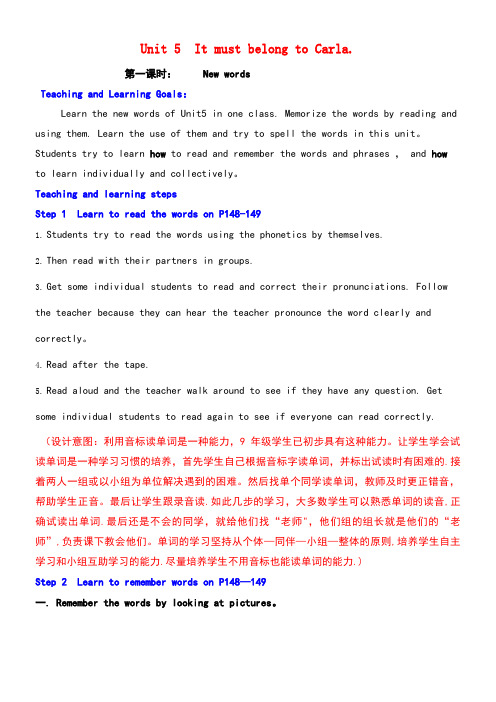
Unit 5 It must belong to Carla.第一课时: New wordsTeaching and Learning Goals:Learn the new words of Unit5 in one class. Memorize the words by reading and using them. Learn the use of them and try to spell the words in this unit。
Students try to learn how to read and remember the words and phrases , and howto learn individually and collectively。
Teaching and learning stepsStep 1 Learn to read the words on P148-1491.Students try to read the words using the phonetics by themselves.2.Then read with their partners in groups.3.Get some individual students to read and correct their pronunciations. Follow the teacher because they can hear the teacher pronounce the word clearly and correctly。
4.Read after the tape.5.Read aloud and the teacher walk around to see if they have any question. Get some individual students to read again to see if everyone can read correctly. (设计意图:利用音标读单词是一种能力,9年级学生已初步具有这种能力。
九年级英语教案 Unit 5 What are the shirts made of

Unit 5 What are the shirts made of?(第1课时)一、教材分析:本节课的主要话题是谈论产品有什么制造及产地。
二、三维目标:1.知识和技能目标:1)谈论产品有什么制造及产地 what is/are sth made of?或Where is/are sth made in ?2) 掌握本课单词和短语be made of /be made in;了解一般现在时态被动语态的结构和用法;归纳和掌握make 构成的短语。
2.过程与方法目标:1)能运用所学知识练习被动语态的句式。
2)能用所学句型进行交际练习。
3.情感、态度和价值观目标:培养学生的听说演等能力及合作学习的意识。
三、教学重点:教学重点: 熟练掌握be made of ; be made in 的运用。
四、教学难点:被动语态的运用及构成。
五、教学策略:通过谈论产品有什么制造及产地,充分掌握被动语态的用法.六、教学准备: 多媒体课件教科书卡片录音机课前预习学案。
七、教学环节:Step 1 情景导入T: Please take out your things on your desk. We use them every day, do you really know them?Questions:Teacher: Can you tell me what these things made of? And where are t hey made?Students: _____________________.①The books are made of paper②The paper is made from tree.环节说明:通过谈论学生的日常用品,激发学生的表达欲望使学生体验到了知识的个人意义Step 2 完成教材1a-1c的任务1. 要求学生翻开课本P33页,快速阅读1a表格部分的内容。
把物品和可能构成他们的材料匹配起来。
九年级英语人教版全册 Unit5_SectionA(3a-3c)优质课教案
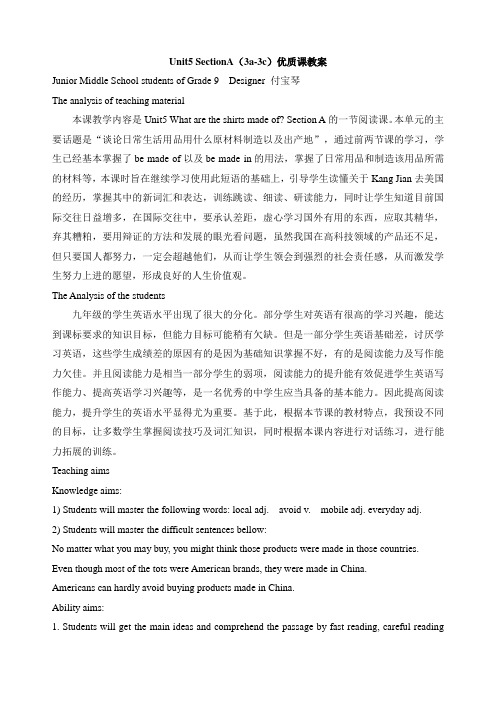
Unit5 SectionA(3a-3c)优质课教案Junior Middle School students of Grade 9 Designer 付宝琴The analysis of teaching material本课教学内容是Unit5 What are the shirts made of? Section A的一节阅读课。
本单元的主要话题是“谈论日常生活用品用什么原材料制造以及出产地”,通过前两节课的学习,学生已经基本掌握了be made of以及be made in的用法,掌握了日常用品和制造该用品所需的材料等,本课时旨在继续学习使用此短语的基础上,引导学生读懂关于Kang Jian去美国的经历,掌握其中的新词汇和表达,训练跳读、细读、研读能力,同时让学生知道目前国际交往日益增多,在国际交往中,要承认差距,虚心学习国外有用的东西,应取其精华,弃其糟粕,要用辩证的方法和发展的眼光看问题,虽然我国在高科技领域的产品还不足,但只要国人都努力,一定会超越他们,从而让学生领会到强烈的社会责任感,从而激发学生努力上进的愿望,形成良好的人生价值观。
The Analysis of the students九年级的学生英语水平出现了很大的分化。
部分学生对英语有很高的学习兴趣,能达到课标要求的知识目标,但能力目标可能稍有欠缺。
但是一部分学生英语基础差,讨厌学习英语,这些学生成绩差的原因有的是因为基础知识掌握不好,有的是阅读能力及写作能力欠佳。
并且阅读能力是相当一部分学生的弱项,阅读能力的提升能有效促进学生英语写作能力、提高英语学习兴趣等,是一名优秀的中学生应当具备的基本能力。
因此提高阅读能力,提升学生的英语水平显得尤为重要。
基于此,根据本节课的教材特点,我预设不同的目标,让多数学生掌握阅读技巧及词汇知识,同时根据本课内容进行对话练习,进行能力拓展的训练。
Teaching aimsKnowledge aims:1) Students will master the following words: local adj. avoid v. mobile adj. everyday adj.2) Students will master the difficult sentences bellow:No matter what you may buy, you might think those products were made in those countries. Even though most of the tots were American brands, they were made in China.Americans can hardly avoid buying products made in China.Ability aims:1. Students will get the main ideas and comprehend the passage by fast reading, careful readingand doing some reading practice.2. Students will retell the passage according to the blackboard design freely.Moral aims:Students believe that China will get better at making high-technology products that people can buy in all parts of the world. And students also know that no matter who they are, they should try their best to make the country stronger and stronger.Teaching key points and difficult points:Teaching key points1) Students will master the key words and phrases.2) Students will get the main ideas and comprehend the passage by fast reading, careful reading and doing some reading practice.Teaching difficult pointsMake up the conversation according to the passage like this:I: Hi! Kang Jian. May I ask you some questions?K: Sure. It’s my pleasure.I: OK, I see. Thanks a lot.K: You are welcome.Teaching methods and learning methods.本课为一节阅读课。
九年级英语 Unit5 It must belong to Carla.教案 人教新目标版

Unit5 It must belong to CarlaSection A一、Teachers’ words :Imagination is more important than knowledge.(想象力比知识更重要)二、Learning aims知识目标:hair band, belong to, make up, because of,author, piic, possibly, drop, appointment, final, anxious, worried, owner能力目标:学习情态动词对现在的情况进行推测情感目标:学习利用相关信息进行合理的推论三、Importances and difficulties:情态动词表推测四、Learning course(一)预习导航1.单词认知作者---------野餐--------可能地-----------最后的--------焦虑的--------约会--------物主--------落下--------2. 短语互译发带----------------属于---------------占,构成-------------becauseof----------much too---------3.尝试翻译下列句子It makes up 30% of the final exam.It’s much too small for him.She’s worried because of her test.(二)自主学习在完成1b听力任务的基础上,能完成下列对话吗?A: Whose volleyball is this?B: ItCarla’s. She loves volleyball.A: How about this toy car?B: Oh, that toy car must J ane’s little brother. He was the only kid at the .And the magazineDengwen. He loves cats.A: Oh and look, someone left a book..B: Oh, yeah. This book must be .Hemingway is her favorite .A: OK. And how about this CD?B: The CD must belong to .She always listens tomusic.(三)合作探究选择正确答案1.We didn’t have the match it rained heavily.A. becauseB. because of2.the heavy rain, We didn’t have the match.A. BecauseB. Because of3.There israin and it’scool this summer.A. too much, much tooB. much too ,too much归纳辨别1.because2.because of3.too much4. much too(四)、拓展延伸在完成2b听力任务的基础上,相信你能完成下面的对话。
2024-2025学年译林版初中英语九年级(上)教案Unit5Reading
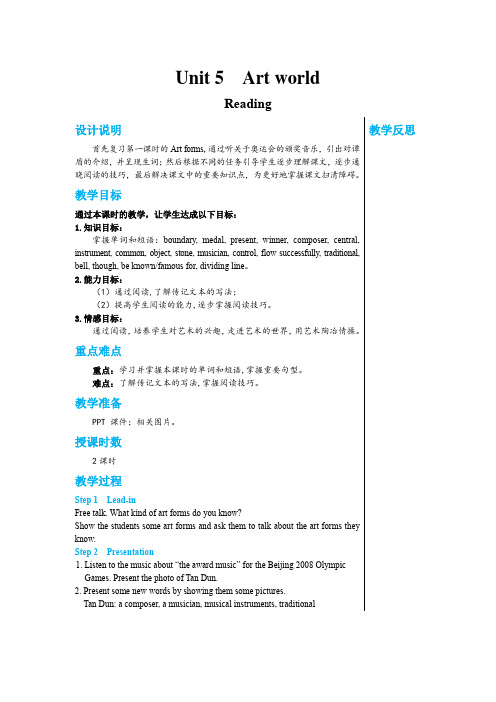
Unit 5 Art worldReading设计说明教学反思首先复习第一课时的Art forms,通过听关于奥运会的颁奖音乐,引出对谭盾的介绍,并呈现生词;然后根据不同的任务引导学生逐步理解课文,逐步通晓阅读的技巧,最后解决课文中的重要知识点,为更好地掌握课文扫清障碍。
教学目标通过本课时的教学,让学生达成以下目标:1.知识目标:掌握单词和短语:boundary, medal, present, winner, composer, central, instrument, common, object, stone, musician, control, flow successfully, traditional,bell, though, be known/famous for, dividing line。
2.能力目标:(1)通过阅读,了解传记文本的写法;(2)提高学生阅读的能力,逐步掌握阅读技巧。
3.情感目标:通过阅读,培养学生对艺术的兴趣,走进艺术的世界,用艺术陶冶情操。
重点难点重点:学习并掌握本课时的单词和短语,掌握重要句型。
难点:了解传记文本的写法,掌握阅读技巧。
教学准备PPT 课件;相关图片。
授课时数2课时教学过程Step 1 Lead-inFree talk. What kind of art forms do you know?Show the students some art forms and ask them to talk about the art forms theyknow.Step 2 Presentation1. Listen to the music about “the award music” for the Beijing 2008 OlympicGames. Present the photo of Tan Dun.2. Present some new words by showing them some pictures.Tan Dun: a composer, a musician, musical instruments, traditional3. Read the new words.4. Match the words with their meanings.Step 3 ReadingTask 1 ScanningGo through the article quickly and match the main idea of each part.Task 2 Further reading1. Read Para. 1. Judge the sentences true(T)or false(F).(1)Tan Dun wrote music for the Beijing 2008 Olympic Games.(2)Tan Dun is a world-famous actor.Answers:(1)T (2)F2. Read Para. 2 about his birth. Fill in the blanks.Year of birth: (1)_______________________________________Place of birth: (2)_______________________________________Place of growth: (3)_____________________________________Best music: (4)_________________________________________What to use to make music: (5)____________________________ Answers: (1) 1958 (2) Hunan, China (3) near the Liuyang River(4) comes from nature (5) made music with common objects like stones and paper 3. Read Para. 3. Ask and answer about his education.(1)Which school did Tan study music in?(2)Where did he go in 1986?(3)Who did he get to know in the USA?(4)What is he best known for?Answers:(1)Tan studied music in the Central Conservatory of Music in Beijing.(2)He went on to study in the USA.(3)He got to know great musicians from around the world.(4)He is best known for winning an Oscar for his music in the film Crouching Tiger, Hidden Dragon.4. Read Para. 4 about his music. Fill in the table.Why is Tan Dun’s music special?Reason He uses a lot of in his music musical5. Read Paras 5-6. Talk about Tan Dun’s influence—He has helped build a bridge between the East and the West.Talk about the meaning of “My music is to dream without boundaries”. Possible answers: He mixes different types of music together, such as the past and present, common objects and musical instruments, traditional Chinese music and modern Western music. For example, he has successfully brought Chinese and Western music together. The music for the Beijing Olympics uses traditional Chinese music and the sounds of an ancient Chinese bell, though it is in a Western style.Task 3 Post-reading1. B2 Read the passage and fill in the card with the information of Tan Dun. Tan DunYear of birth: (1)_______________________________________Place of birth: (2)___________________________________Interest(s): (3)_______________________________________Job: (4)_____________________________________________ Education: studied music at a university in (5)___________went on to study in (6) ___________Best known for: winning an (7)__________ for the music in a filmHis music: uses (8)__________ a lotbuilds a bridge (9)__________Answers: (1) in 1958 (2) in central Hunan, China (3) music (4) a composer (5) Beijing (或1978) (6) the USA (7) Oscar (8) the sounds of nature (9) between the East and the West2. B3 Read the passage and complete the conversation.Answers: (1) composers (2) award (3) nature (4) instruments (5) controlling (6) flow (7) common (8) traditional (9) ancient (10) WesternStep 4 Production1. Have an interview.Suppose the writer of this passage will come to our class, we will have an interview. Work in groups of 4. One student is the writer and the other students will ask him 2-3 questions about Tan’s life and work.2. Have a discussion.Why can Tan Dun achieve success? What can we learn from him?Step 5 Language points1. Each time a medal was presented to a winner at the Beijing 2008 Olympic Games, the award music was played. 在2008年北京奥运会上,每次给获胜者颁奖时,颁奖音乐就会被播放。
车道中学 杨宗峰 新目标九年级英语教案 unit 5
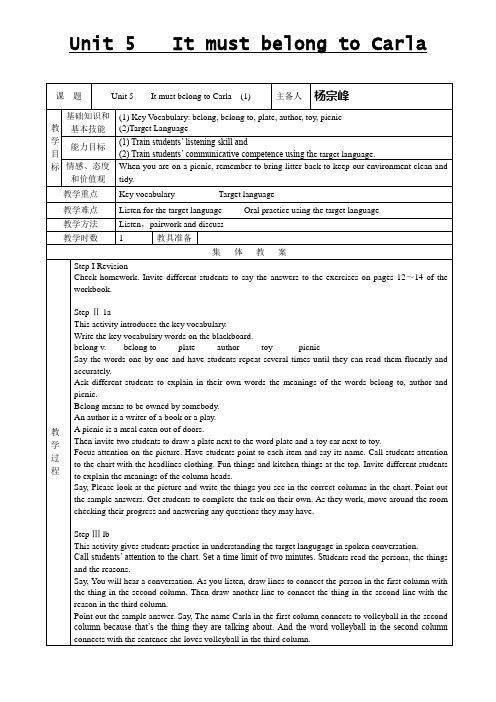
Say, In this class, we’ve learned the key vocabulary words belong to, plate, author, toy and picnic and done much listening and oral practice using the target language.
Point to the picture in Activity lb. Invite pair of students to say the conversation in the speech bubbles.
SA: Whose volleyball is this?
SB: It must be Carla’s. She loves volleyball.
教学过程
Step I Revision
Check homework. Invite different students to say the answers to the exercises on pages 12~14 of the workbook.
Step Ⅱ1a
This activity introduces the key vocabulary.
教学重点
Key vocabulary Target language
教学难点
Listen for the target language Oral practice using the target language
教学方法
Listen,pairwork and discuss
教学时数
1
教具准备
集体教案
Step Ⅵ Homework
九年级英语全册 Unit 5 (第2课时)教案

Unit 5 What are the shirts made of?(第2课时)一、教材分析:本节课的主要话题是谈论产品由什么制造及其产地,同时在文中巩固复习被动语态的构成及应用。
二、三维目标(一) 知识与技能1. To learn more about passive voice.2. To understand the pasage on Page35.(二) 过程和方法3. To get a general knowledge of the passage by reading and role-play.4. To know how to make sentences and express correctly using passive voice.(三) 情感态度和价值观5. After learning this part, every student will know more about products and learnto be cooperative in the course of learning.三、教学重点1. Further learning about passive voice.2. to understand the passage on Page 35.四、教学难点1. To know the sentence pattern: find it + 宾补 + that …2. to understand the passage on Page 35.五、教学策略根据本课教学目标和重点内容,教师可采用听,读,小组讨论,角色扮演等活动来引导学生进行学习。
六、教学准备ppt, recorder, mutiple-media七、教学环节1、课堂导入Step 1 Lead-inRole—play\Role—play the conversation on Page 34Pam: China is famous for tea, right?Liu Jun: Yes, both in the past and now.Pam: Where is tea produced in China?Liu Jun: Well, in amny different areas. For example, Anxi and Hangzhou are widely known for their tea.2. 课堂讲授Step 2. Reading1) Fast-readingNow turn to page 35 and read the page quickly to find answers to the questions.1.Where did Kang Jian go to visit his uncle and aunt?2.What did he discover in the toy stores?3.Why did he have to visit many stores before buying a pair ofbasketball shoes?4.What did he realize after his shopping experiences?Answers:1. He went to San Francisco.2. Most of the toys had American brands, but they were made in China.3. He want to find a pair of shoes made in America.4. He realized that Americans can hardly avoid buying products made in China.2) careful-readingRaed the passage again and write what the underlined word refer to.1. No matter what yoy may buy, you might properly think those products were madein those countries.those:_______________________those: ______________________2. He found it interesting that so many products in local shops were made of China. it: ____________________________3. I want to buy a toy car for my cousin, but even though most of the toys hadAmerican brands, they were made in China.they:_______________________Answers: 1. the products he saw in other countriesJapan, France, Switzerland…2. so many products in local shops were made of China3. most of the toys he saw in America3) Studying useful structures.1) He found it interesting that so many products in local shops were made of China.本句结构为:Find + it + 宾补+ that / to do…It在句中为形式宾语。
j九年级英语unit5教案、反思
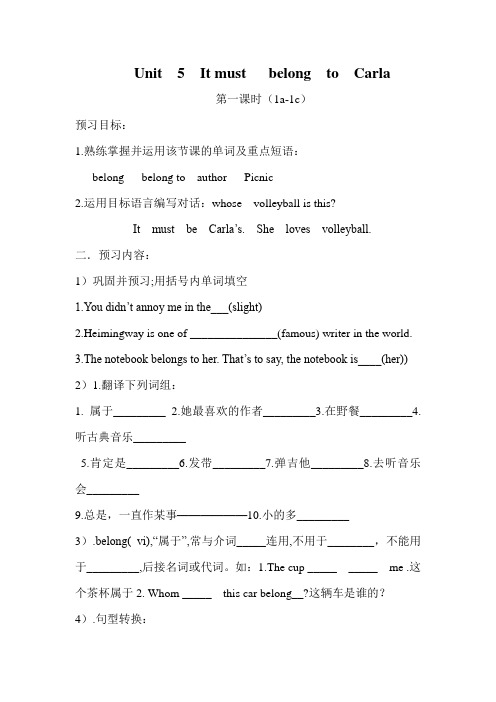
Unit 5 It must belong to Carla第一课时(1a-1c)预习目标:1.熟练掌握并运用该节课的单词及重点短语:belong belong to author Picnic2.运用目标语言编写对话:whose volleyball is this?It must be Carla‟s. She loves volleyball.二.预习内容:1)巩固并预习;用括号内单词填空1.You didn‟t annoy me in the___(slight)2.Heimingway is one of _______________(famous) writer in the world.3.The notebook belongs to her. That‟s to say, the notebook is____(her)) 2)1.翻译下列词组:1. 属于_________2.她最喜欢的作者_________3.在野餐_________4.听古典音乐_________5.肯定是_________6.发带_________7.弹吉他_________8.去听音乐会_________9.总是,一直作某事——————10.小的多_________3).belong( vi),“属于”,常与介词_____连用,不用于________,不能用于_________,后接名词或代词。
如:1.The cup _____ _____ me .这个茶杯属于2. Whom _____ this car belong__?这辆车是谁的?4).句型转换:This sweater must be Li Ming‟s= This sweater______ _____ ______ LiMing.语法练习:5).It must be Mary‟s. must 是_____ 动词,表\意为:肯定,一定。
一般用_________,must be表示“_________,_________”把握性比较大。
英语人教版九年级上册Unit5全单元教案
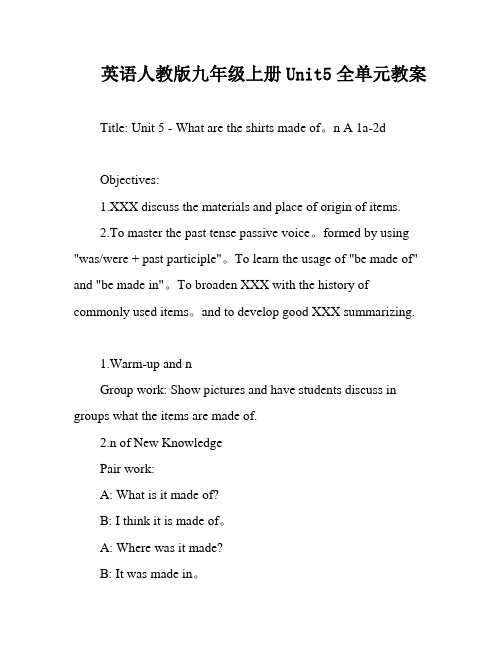
英语人教版九年级上册Unit5全单元教案Title: Unit 5 - What are the shirts made of。
n A 1a-2dObjectives:1.XXX discuss the materials and place of origin of items.2.To master the past tense passive voice。
formed by using "was/were + past participle"。
To learn the usage of "be made of" and "be made in"。
To broaden XXX with the history of commonly used items。
and to develop good XXX summarizing.1.Warm-up and nGroup work: Show pictures and have students discuss in groups what the items are made of.2.n of New KnowledgePair work:A: What is it made of?B: I think it is made of。
A: Where was it made?B: It was made in。
Work on 1a:XXX asks students what the things are usually made of and matches them with the materials.3.Work on 1b:Task 1: XXX.Task 2: Listen and match the products with their materials and place of origin.4.Work on 1c:A: This ring looks nice。
九年级英语全册 Unit 5A(2d)教案 (新版)人教新目标版.doc

看起来他在考试前一点都不紧张。
____ that he was not a bit nervous before the exams.
【解析】用“It seems that…”结构,再由was确定seem要用过去式。正确答案是It seemed。
3、For example,Anxi and Hangzhou are widely known for their tea.比如,安溪和杭州因茶叶而广为人知。
B: I argued with my parents.
A: I don’t think it’s polite.
B: I think so, but my parents didn’t allow me to throw some old things away.
A: What are they?
The area is famous as a green tea producing place.
当主语是事物名词时,be famous for表示“以其内容、特征、价值等而被人所知”;be famous as则表示“以某种形式出名”。
This grammar book is famous for its practical usage.
4. begin _____________ _____________
5. blow _____________ _____________
6.break _____________ _____________
7.bring _____________ _____________
8.bulid _____________ _____________
2.As far asI know , tea plantsare grownon the side of mountains.
九年级英语第五单元教案Unit5Whataretheshirtsmadeof

Unit 5 What are the shirts made of?Unit 5 Section A 1 (1a-2d)一、教学目标:1. 语言知识目标:1) 能掌握以下单词:chopsticks, coin, fork, blouse, silver, glass, cotton, steel,grass, leaf, produce, widely, be known for, process, pack 能掌握以下句型:① —This ring looks nice. Is it made of silver? —Yes, and it was made in Thailand.② What is it made of/from?③ China is famous for tea, right?④ Where is tea produced in China?2) 能够用英语描述及询问物品的制作材料,正确理解被动语态的用法及句子结构。
2. 情感态度价值观目标:了解一些日常常利用品的制成材料,增加生活常识,养成良好的生活习惯;了解一些地方知名产品或传统艺术品的制作进程和制作材料,培育学生的民族自豪感及爱国主义精神。
二、教学重难点1. 教学重点:1) 掌握本课时中出现的生词2) 能够用英语描述及询问物品的制作材料3)正确理解被动语态的用法及句子结构。
2. 教学难点:理解被动语态的用法及句子结构。
三、教学进程Ⅰ. Lead in1. 播放动画片《造纸进程》的视频,让学生们了解这个中国传统发明的情况。
T: Who invented paper first? S1: Can Lun invented it in Han dynasty.T: What was paper made of then? S2: It was mainly made of bamboo.T: was it easy for people to make paper then? S1: No, it was very difficult then.T: What is paper made of now? S3: It’s mainly made of wood, bamboo, and cotton.…Ⅱ. Presentation1. Present the sentence structure, using the pictures on the big screen:—What’s the golden medal made of? —It’s made of gold.—Is this table made of wood? —No, it isn’t. It’s made of glass.—Is Butter made from meat? —No. It’s made from cream?让学生们学习掌握be made of/from句型的用法,及be made of与be made from的区别。
九年级英语全册 Unit 5 What are the shirts made of Section A(3a-3c)教案 (新版)人教新目标版

24.feed _____________ _____________
25.feel _____________ _____________
26.fight _____________ _____________
27.find _____________ _____________
Questions:
1. Do you want to know where your everyday things made ?
_______________________________________
2. Can you see the word“made inChina”when you buy something in the shop?_________________________________________
Toys are not the only things made inChina.“I wanted to buy a pair of basketball shoes,”he.“But I had to visit five or six storesfinding a pair made in America!”He realized that Americans can hardlybuying products made inChina.“In fact,”he continues,“there are so many things made in China —footballs, handbags, pet food, mobile phones.American flags are made in China!”Kang Jian thinks it’s great that China is so good at making these everyday things. However, he wishes that in the futureChinawill also get better at making high-technology products that people can buy in all parts of the world.
人教版九年级英语Unit 5 What are the shirts made of 全单元教案
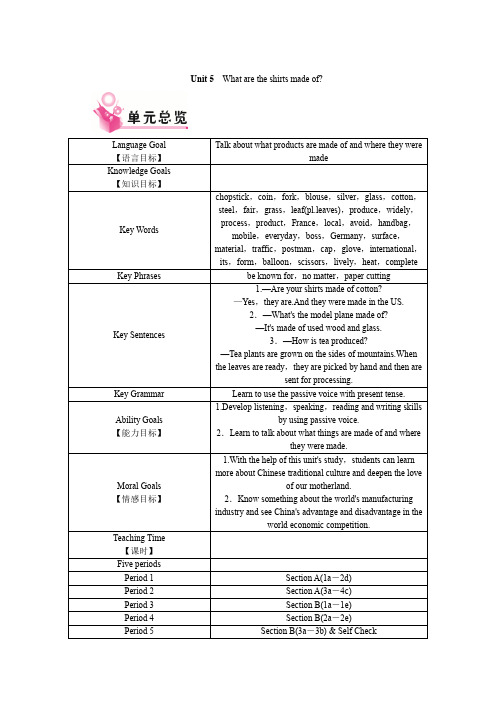
Unit 5What are the shirts made of?Language Goal 【语言目标】Talk about what products are made of and where they weremadeKnowledge Goals 【知识目标】Key Words chopstick,coin,fork,blouse,silver,glass,cotton,steel,fair,grass,leaf(pl.leaves),produce,widely,process,product,France,local,avoid,handbag,mobile,everyday,boss,Germany,surface,material,traffic,postman,cap,glove,international,its,form,balloon,scissors,lively,heat,completeKey Phrases be known for,no matter,paper cuttingKey Sentences1.—Are your shirts made of cotton?—Yes,they are.And they were made in the US.2.—What's the model plane made of?—It's made of used wood and glass.3.—How is tea produced?—Tea plants are grown on the sides of mountains.When the leaves are ready,they are picked by hand and then aresent for processing.Key Grammar Learn to use the passive voice with present tense.Ability Goals 【能力目标】1.Develop listening,speaking,reading and writing skillsby using passive voice.2.Learn to talk about what things are made of and wherethey were made.Moral Goals 【情感目标】1.With the help of this unit's study,students can learn more about Chinese traditional culture and deepen the loveof our motherland.2.Know something about the world's manufacturing industry and see China's advantage and disadvantage in the world economic competition.Teaching Time【课时】Five periodsPeriod 1Section A(1a-2d)Period 2Section A(3a-4c)Period 3Section B(1a-1e)Period 4Section B(2a-2e)Period 5Section B(3a-3b) & Self Check本单元的话题是谈论日常生活用品是用什么材料制造的以及出产地是什么地方,要求学生学习并掌握一些日常生活用品的名称和制造的材料的基本词汇,同时在语言学习训练中接触并学习被动语态。
牛津译林版英语九年级上册Unit5教案教学设计
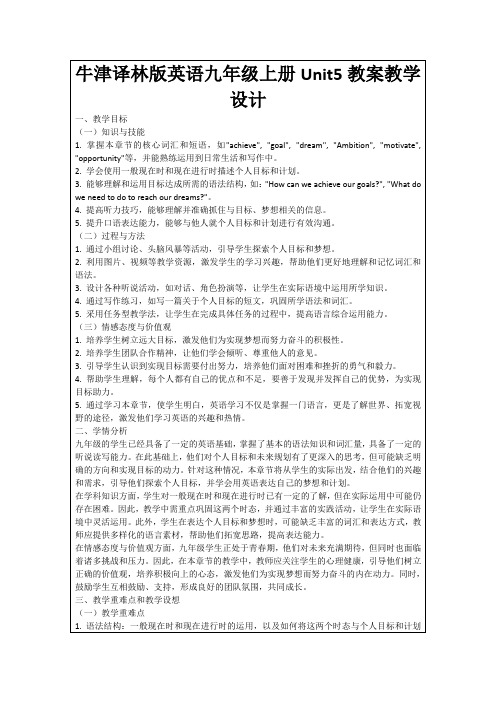
1.教师带领学生回顾本节课所学内容,强调重点词汇、短语和语法知识。
2.学生分享学习收获,教师给予肯定和鼓励,并提出改进建议。
3.教师总结:This lesson, we have learned how to talk about our dreams and goals in English. Remember, achieving our goals requires not only hard work, but also perseverance and courage. Keep your dreams in your heart and take practical actions to make them come true.(本节课,我们学习了如何用英语谈论我们的梦想和目标。记住,实现我们的目标不仅需要努力,还需要坚持和勇气。把梦想放在心里,付诸实践行动,让它们成为现实。)
5.通过学习本章节,使学生明白,英语学习不仅是掌握一门语言,更是了解世界、拓宽视野的途径,激发他们学习英语的兴趣和热情。
二、学情分析
九年级的学生已经具备了一定的英语基础,掌握了基本的语法知识和词汇量,具备了一定的听说读写能力。在此基础上,他们对个人目标和未来规划有了更深入的思考,但可能缺乏明确的方向和实现目标的动力。针对这种情况,本章节将从学生的实际出发,结合他们的兴趣和需求,引导他们探索个人目标,并学会用英语表达自己的梦想和计划。
3.能够理解和运用目标达成所需的语法结构,如:"How can we achieve our goals?", "What do we need to do to reach our dreams?"。
4.提高听力技巧,能够理解并准确抓住与目标、梦想相关的信息。Байду номын сангаас
牛津译林版九年级英语上册Unit 5 Integrated skills 示范课教案
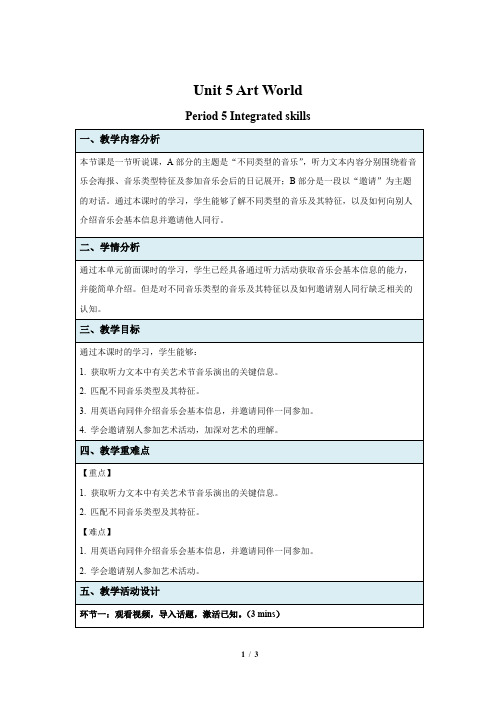
通过本单元前面课时的学习,学生已经具备通过听力活动获取音乐会基本信息的能力,并能简单介绍。但是对不同音乐类型的音乐及其特征以及如何邀请别人同行缺乏相关的认知。
三、教学目标
通过本课时的学习,学生能够:
1.获取听力文本中有关艺术节音乐演出的关键信息。
2.匹配不同音乐类型及其特征。
3.用英语向同伴介绍音乐会基本信息,并邀请同伴一同参加。
Unit 5ArtWorld
Period 5 Integrated skills
一、教学内容分析
本节课是一节听说课,A部分的主题是“不同类型的音乐”,听力文本内容分别围绕着音乐会海报、音乐类型特征及参加音乐会后的日记展开;B部分是一段以“邀请”为主题的对话。通过本课时的学习,学生能够了解不同类型的音乐及其特征,以及如何向别人介绍音乐会基本信息并邀请他人同行。
3. PreviewStudy skills.
4.学会邀请别人参加艺术活动,加深对艺术的理解。
四、教学重难点
【重点】
1.获取听力文本中有关艺术节音乐演出的关键信息。
2.匹配不同音乐类型及其特征。
【难点】
1.用英语向同伴介绍音乐会基本信息,并邀请同伴一同参加。
2.学会邀请别人参加艺术活动。
五、教学活动设计
环节一:观看视频,导入话题,激活已知。(3mins)
教师引导学生完成听音回答及看图说话活动,进行听前准备。
教学活动
2. Studentslisten and answer the question.
3. Studentslook at the pictures and talk.
活动层次
学习理解之感知与注意、获取与梳理
效果评价
人教版九年级英语Unit5全英文教案新目标-人教新目标版九年级全册
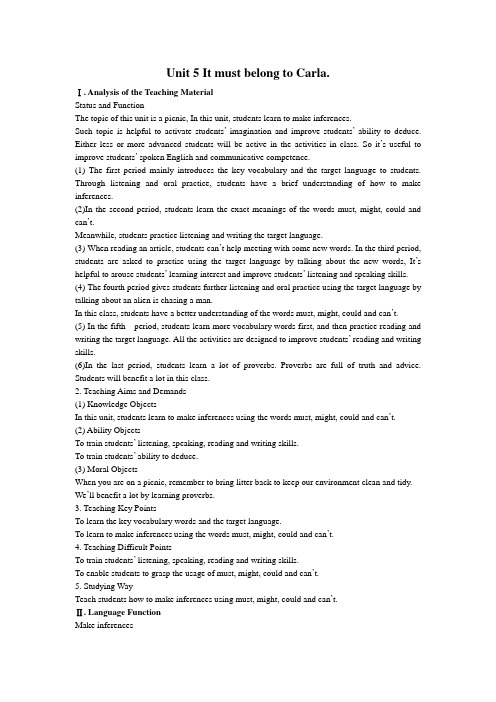
Unit 5 It must belong to Carla.Ⅰ. Analysis of the Teaching MaterialStatus and FunctionThe topic of this unit is a picnic, In this unit, students learn to make inferences.Such topic is helpful to activate students’imagination and improve students’ability to deduce. Either less or more advanced students will be active in the activities in class. So it’s useful to improve students’ spoken English and communicative competence.(1) The first period mainly introduces the key vocabulary and the target language to students. Through listening and oral practice, students have a brief understanding of how to make inferences.(2)In the second period, students learn the exact meanings of the words must, might, could and can’t.Meanwhile, students practice listening and writing the target language.(3) When reading an article, students can’t help meeting with some new words. In the third period, students are asked to practise using the target language by talking about the new words, It’s helpful to arouse students’ learning interest and improve students’ listening and speaking skills. (4) The fourth period gives students further listening and oral practice using the target language by talking about an alien is chasing a man.In this class, students have a better understanding of the words must, might, could and can’t. (5) In the fifth period, students learn more vocabulary words first, and then practice reading and writing the target language. All the activities are designed to improve students’ reading and writing skills.(6)In the last period, students learn a lot of proverbs. Proverbs are full of truth and advice. Students will benefit a lot in this class.2. Teaching Aims and Demands(1) Knowledge ObjectsIn this unit, students learn to make inferences using the words must, might, could and can’t. (2) Ability ObjectsTo train students’ listening, speaking, reading and writing skills.To train students’ ability to deduce.(3) Moral ObjectsWhen you are on a picnic, remember to bring litter back to keep our environment clean and tidy. We’ll benefit a lot by learning proverbs.3. Teaching Key PointsTo learn the key vocabulary words and the target language.To learn to make inferences using the words must, might, could and can’t.4. Teaching Difficult PointsTo train students’ listening, speaking, reading and writing skills.To enable students to grasp the usage of must, might, could and can’t.5. Studying WayTeach students how to make inferences using must, might, could and can’t.Ⅱ. Language FunctionMake inferencesⅢ. Target LanguageWhose volleyball is this?It must be Carla’s. She loves volleyball.It could be Ted’s.Ⅳ. Structuremust, might, could and can’tⅤ. Vocabularypicnic, chase, escape, belong to, toy car, plate’, mystery, appointment, worried, wake, neighbor, garbageⅥ. Recyclingsuit, land, volleyball, magazine, book, CD, bat, earring, T-shirt, UFO, whose, owner, exercise, dream, anxiousⅦ. Learning Strategies1. Sequencing2. DeducingⅧ. Teaching TimeSix periodsThe First PeriodI. Teaching Aims and Demands1. Knowledge Objects(1) Key V ocabularybelong, belong to, plate, author, toy, picnic(2)Target LanguageWhose book is this?It must be Mary’s. Wanda Wilbur is her favourite author.2. Ability Objects(1) Train students’ listening skill.(2) Train students’ communicative competence using the target language.3. Moral ObjectsWhen you are on a picnic, remember to bring litter back to keep our environment clean and tidy. Ⅱ.Teaching Key Points1. Key vocabulary2. Target languageⅢ.Teaching ProceduresStep I RevisionCheck homework. Invite different students to say the answers to the exercises on pages 12~14 of the workbook.Step Ⅱ1aThis activity introduces the key vocabulary.Write the key vocabulary words on the blackboard. Say the words one by one and have students repeat several times until they can read them fluently and accurately.Ask different students to explain in their own words the meanings of the words belong to, author and picnic.Belong means to be owned by somebody.An author is a writer of a book or a play.A picnic is a meal eaten out of doors.Then invite two students to draw a plate next to the word plate and a toy car next to toy.Focus attention on the picture. Have students point to each item and say its name. Call students attention to the chart with the headlines clothing. Funthings and kitchen things at the top. Invite different students to explain the meanings of the column heads.Say, Please look at the picture and write the things you see in the correct columns in the chart. Point out the sample answers. Get students to complete the task on their own. As they work, move around the room checking their progress and answering any questions they may have.Show the correct answers on the screen by a projector.Step ⅢlbThis activity gives students practice in understanding the target langugage in spoken conversation. Call students’ attention to the chart. Set a time limit of two minutes. Students read the persons, the things and the reasons.Say, You will hear a conversation. As you listen, draw lines to connect the person in the first column with the thing in the second column. Then draw another line to connect the thing in the second line with the reason in the third column.Point out the sample answer. Say, The name Carla in the first column connects to volleyball in the second column because that’s the thing they are talking about. And the word volleyball in the second column connects with the sentence she loves volleyball in the third column.Play the recording the first time.Students only listen. Play the recording again. This time students listen and match each person with a thing and a reason.Check the answers.Step Ⅳ1cThis activity provides oral practice using the target language.Point to the picture in Activity lb. Invite pair of students to say the conversation in the speech bubbles.Point out the conversation in the box. Invite another pair of students to say it to the class. S A : Whose book is this?S B: It must be Mary’s. Wanda Wilbur is her favourite author.Write the conversation on the blackboard.Point out the chart in Activity 1b. Say.Now work with a partner. Start by reading the conversations in the picture and in the box: Then make conversations using the information in the chart in Activity 1b. Talk about who each thing might belong to and give a reason. Get students to practice in pairs. As they work, move around the classroom listening in on various pairs and offering help with language and pronunciation as needed.After all the students have had an opportunity to ask and answer questions, stop the activity. Get different pairs of students to say their conversations to the class.Step ⅤSummarySay, In this class, we’ve learned the key vocabulary words belong to, plate, author, toy and picnic and done much listening and oral practice using the target language.Step ⅥHomework(1) Say and remember the spelling of the vocabulary words.(2)Say the conversations in Activity 1c to get a further understanding of the target language.Unit 5 It must belong to Carla.The Second PeriodI. Teaching Aims and Demands1. Knowledge Objects(1) Key V ocabularydrop, symphony, optometrist, appointment, algebra, crucial, count, because of, Chinese-English dictionary, Oxford University(2) Target LanguageWhat do you think "anxious" means?Well, it can’t mean "happy".It might mean "worried".Oh, yes, she is worried because of her test.Here are some earrings. The owner can’t be a boy.Well, it could be a boy. The earrings might be a present for his mother.2. Ability Objects(1) Train students’ reading skill.(2) Train students’ communicative competence using the target language.Moral ObjectWhen you are in trouble, send an e-mail message to your friends to ask for help.Ⅱ. Teaching Key Points1.Reading practice2.Oral practice using the target languageⅢ. Teaching Difficult Points1. Key vocabulary2. Target languageⅣ. Teaching ProceduresStep I RevisionRevise the usage of the words must, might, could and can’t by checking homework.Ask students to exchange their exercises books and help correct any errors with each other, As they are doing this, move around the classroom offering language support as needed. Then invite different students to say their sentences to the class.Step Ⅱ3aThis activity provides reading practice using the target language.Call students’attention to the picture.Ask students to tell what’s happening in the picture.T: What’s the girl doing?S s: She is using the computer to write e-mail.Point to the parts of the e-mail message.Tell students that this is the message the girl in the picture writes. Say, Right now the parts are in the wrong order. When they are in the right order, they will make a clear message. Now please read the parts carefully. Number them in order. When you are doing this, you will meet with some words you don’t know.Don’t worry too much about them. Just circle them. We’ll talk about what they mean later.Get students to complete the task on their own. Point out the sample answer.Say. The first sentence of the e-mail message is I’m really anxious, because I can’t find my backpack.Check the answers.Step Ⅲ3bThis activity provides oral practice using the target language.Read the instructions to the class. Point to the sample conversation. Invite a pair of students to say it to the class.S A: What do you think "anxious" mean? S B: Well, it can’t mean "happy".S A: It might mean "worried". S B: Oh, yes. She is worried because of her test.Write the conversation on the blackboard.Say, You are to talk about the circled words in Activity 3a. Use the words can’t, must, could or might as in the sample.Get students to work with a partner. As they work in pairs, move around the classroom helping students with pronunciation and answering any questions they may have. Some time later, stop the activity. Ask different students to share their conversations with the class. Make a list of the words students are talking about on the blackboard.Practice the pronunciation of these words and explain the meaning of each word. Step ⅣPart 4This activity provides oral practice using the target language.Call students’ attention to the picture. Get students to name each item in it.Write the new words Chinese-English dictionary and Oxford University on the blackboard. Point to the sample conversation. Invite a pair of students to read it to the class.Write the conversation on the black board. Explain the meaning of each sentence. Focus attention on the chart with the headlines Can’t, Could/might and Must at the top. Point out the sample answer.Read the instructions to the class.Get students to complete the task in pairs. As the pairs work together, move around the classroom helping students with pronunciation, sentence formation or anything else they ask for help with.Ask some pairs to say their conversations to the class.Note: Answers to the chart will vary.Step ⅤSummarySay, In this class, we’ve learned some vocabulary words, such as drop, symphony.And we’ve done much oral practice using the target language.Step ⅥHomework1. Read the letter in Activity 3a again for further understanding of the vocabularywords.2. Read the conversations in Activities 3b and 4 again for further understanding of the target language.3. Finish off the exercises on pages 15~16 of the workbook.The Third PeriodI. Teaching Aims and Demands1. Knowledge Objects(1) Key Vocabulary:chase, creature(2) Target LanguageWhy do you think the man is running?He could be running for exercise.No, he’s wearing a suit. He might be running to catch a bus.2. Ability Objects(1)Train students’ listening skill.(2)Train students’ writing skill.3. Moral ObjectThe UFO and alien are both unreal. As students, we must work hard to explore the universe in the future.Ⅱ. Teaching Key Points1. Listening practice2. Writing practiceⅢ. Teaching Difficult Points1. Write a sentence about each picture.2. Write two or three sentences to finish the story.3. Listen and complete the sentences.Ⅳ. Teaching ProceduresStep ⅠRevision1. Invite a student to read the thank you message Linda wrote to Anna to the class.2. Get different pairs of students to read the conversations in Activities 3band 4.3. Check answers to the exercises on pages 15~16 of the workbook.StepⅡPart lThis activity provides writing practice using the target language.Read the instructions to the class. Read the words in the box and have students repeat several times. Invite different students to explain the meaning of each word in their own words.Get students to look at the three pictures carefully. Say, You are to use the words from the box to write a sentence about each picture. Point out where to write the sentences. Ask a student to say the sample answer to the class. Get students to complete the activity individually. As students work, walk around the classroom offering language support as needed.Check the answers on the blackboard.Step Ⅲ2aThis activity gives students practice understanding and writing the target language in spoken conversation.Read the instructions to the class. Point to the three pictures in Activity 1. Say, You will hear a conversation about these pictures. As you listen, write a number in the box in the left corner of each picture to show the order of the events.Point out the sample answer in the box of the third picture. Say, You will hear the man is running first. Play the recording the first time. Students only listen. Play the recording again. This time students listen and number the pictures. Encourage students to write two or three sentences to finish the story.Answers will vary. Write a sample version on the blackboard. Ask students to use it as a model.Step Ⅳ2bThis activity gives students practice listening to and writing the target language.Point to the chart with sentence startersThey see …The man says…and The woman says…Say, You are to listento the same recording again. And complete each sentence.Point out the sample answers. Say, They see a man running. The man says he could be running for exercise. The woman says he might be late for work. Explain the meaning of the word creature to the students.Play the recording once or twice, using the Pause button as necessary.Show the answers on the screen by a projector so thatStep Ⅴ2cThis activity provides oral practice using the target languagePoint out the sample conversation in the box. Invite a pair of students to read it to the class.S A: Why do you think the man is running?S B: He could be running for exercise.S A: No, he’s wearing a suit. He might be running to catch a bus.Write it on the blackboard.Say, Now work with a partner. Start by reading the conversation in the box with your partner. Then role play conversations using information in Activity 2b.Get students to work in pairs. As the pairs work together, walk around the classroom listening in on various pairs and offering help needed. Ask several pairs to say their conversations to the class.Step ⅥSummarySay, In this class, we’ve mainly done much listening and writing practice using the target language.Step ⅦHomeworkAsk students to collect pictures of different kinds and then talk about them using must, could, might and can’t.The Fourth PeriodI. Teaching Aims and Demands1. Knowledge Objects(1) Key Vocabularyextremely, worried, neighbor, garbage, mystery, director, escape, ocean(2) Target LanguageIn my dream, I was swimming in an ocean of paper.Maybe it means you’re afraid of too much homework!2. Ability Objects(1) Train students’ reading skill. (2) Train students’ writing skill.(3) Train students’ integrating skills.3. Moral ObjectEveryone has had a dream. But don’t dream away your time.Ⅱ. Teaching Key Points1. Key vocabulary2. Reading practice3. Writing practiceⅢ. Teaching Difficult Points1. Reading practice2. Writing practiceⅣ. Teaching ProceduresStep ⅠRevisionCheck homework.Collect pictures from students on the teacher’s desk. Hold up one at a time and ask students to describe it using the target language introduced in the preceding classes. For example:T: (Holding up a picture with a boy swimming in an ocean of books) What do you think is happening to the person in the picture?S1: He must be a student. S2: He could be having a dream. S3: He might like reading books. Step Ⅱ3aThis activity provides reading practice using the target language.Show the key vocabulary words on page 38 on the screen by a projector.Say the words one by one and have students repeat several times until they can pronounce them fluently and accurately. Read the title of the newspaper article strange events in Bell Tower neighborhood to the class. And then point to the picture and ask students. How is the person feeling? Help students to answer. He is confused and upset.Call students’ attention to the article. Read it to the class. Say, Now please read the article individually and underline what people think could be causing the strange things that are happening in Bell Tower. Point out the sample answer.Get students to complete the task individually. As they work, walk around the classroom answering any questions they may have and offering help as needed. Check the answers.Answersan animal, teenagers, the wind, a dogStep Ⅲ3bThis activity provides reading and writing practice using the target language.Get students to discuss any words or sentences they don’t know in Activity 3a with one another. Call students’attention to the three sets of notes. Ask different students to read them to the class.Chu family--late night footsteps in the hallway--might be the neighborsLao Zheng--someone trying to get in the window--might be the windXiao Ning--finds garbage in front of her house--might be catsSay, You are to write another paragraph about Bell Town using these notes. You may use the article inActivity 3a as a model. Ask students to write their paragraphs on their own in the exercise books. As they work, move around the classroom offering language support as needed. Get a few students to read their works to the class. Answers will vary. Write the sample version on the blackboard.Step Ⅳ3cThis activity provides writing practice using the target language.Read the title No more mystery in Bell Tower neighborhood to the class and explain the meaning of the word mystery. Invite a student to read the opening sentences to the class. Divide the class in to groups of four to discuss what should be included in the article.Two or three minutes later, stop the activity. Say, Now please finish the article about the strange events in Bell Tower. Use the ideas you discussed along with original ideas of your own to complete the article. Get students to complete the task on their own in the exercise books. As they are writing, move around the classroom offering help as needed. Ask some students to read their articles to the class.Collect students’ works and write a comment on each paper before returning them.Step ⅤPart 4This activity provides reading, writing, listening and speaking practice using the target language. Read the instructions to the class. Point to the picture. Ask students to tell what is happening in it. Invite a pair of students to read the sample conversation in the box to the class.Say, Once I had a dream. In my dream, I was eating a state dinner. What might the dream mean? Students may answer.Maybe it means you are too hungry. Say. Think of a dream you had recently and tell your classmates about it Your classmates guess what the dream might mean. Please work with a partner. Start practice by reading the sample conversation. As the pairs work together, walk around the room offering help with pronunciation and language. Ask different pairs to tell the class about their dream and what they may mean.Step ⅥSummarySay, In this class, we’ve mainly done much reading and writing practice using the target language. We’ve learned some vocabulary words as well.Step ⅦHomework1. Reread the newspaper article in Activity 3a.2. Review the paragraph in Activity 3b,The Fifth PeriodI. Teaching Aims and Demands1. Knowledge Objects(1)Key Vocabularyfinger, stone, ant, poor, dishonest, bark, wake, pretend, use up, attempt(2)Fill in blanks and make sentences using vocabulary words.(3)Learn some proverbs.(4)Circle the word that doesn’t belong.2. Ability Objects(1)Train students’ writing skill.(2)Train students’ ability of reading comprehension.(3)Train students’ ability of clarifying.3. Moral ObjectWe’ll benefit a lot by learning proverbs.Ⅱ. Teaching Key Points1. Make sentences using vocabulary words.2. Say the meanings of different proverbs in your own words.3. Circle the word that doesn’t belong.Ⅲ. Teaching Difficult Points1. Make sentences using vocabulary words.2. Say the meanings of different proverbs in your own words.Ⅳ.Teaching ProceduresStep ⅠRevisionAsk several students to read the newspaper article in Activity 3a to the class.Step ⅡPart 1This activity provides a comprehensive review of vocabulary presented in the unit.of the word, for example adjusting for tense or subject/verb agreement.Ask students to fill in the blanks on their Own.Check the answers. Five students each read a sentence, filling in the blanks. The rest of the students check their answers.Answers1. favourite2. careful3. anxious4. worried5. strangeAsk students to make their own sentences with the words, preferably sentences that are meaningful. Move around the room. Collect a few students’answers with mistakes on the blackboard.Help correct the mistakes.Sample answers1. What’s your favourite song?2. Be careful while crossing a road.3. We are anxious for his safety.4. You don’t have to be worried about me.5. I had a strange dream last night.Step ⅢPart 2This activity provides reading, writing, listening and speaking practice using the target language. Show the vocabulary words on the screen by a projector.Say the words and have students repeat them until they can pronounce them fluently and accurately. Read the instructions to the class. Explain to the students that a proverb is a short well-known saying that states a general truth or gives advice.Read the first proverb to the class. One finger cannot lift a small stone. Elicit the interpretation from the students(It’s better to have help to do even small jobs).Say, Please read the proverbs, Discuss with your classmates what they might mean.Get students to work in groups of four.As the groups work together, walk around the room to make sure that students are discussing the topic in English. Invite different students to say what they think each proverb means.There can be more than one interpretation for each proverb. Check the answers by showing the sample answers on the screen by a projector.Step ⅥPart 3This activity focuses on the new vocabulary introduced in this unit.Ask students to read the five lines of words in the box.Point out the first line. In this line, escape, chase and run are all verbs. However, the word owner is a noun. So we circle it. Now please circle the word that doesn’t belong in each line.Get students to complete the task on their own. As they are doing this, move aroundthe classroom checking their progress and offering help as needed.Check the answers by asking a student to read his or her circled words to the class. Answers :1. owner 2. alien 3. land 4. exercise 5. lostStep ⅤJust for Fun!This activity provides reading and speaking practice with the target language.Ask all the students to read the cartoon story. Ask students why it is funny. Help students to answer. The boys think they are going to land on an island. Instead, they have landed on the back of a whale.Step ⅥSummarySay. In this class, we’ve practiced filling in blanks and making sentences with some vocabulary words introduced in this unit. And we’ve learned several proverbs.StepⅦHomework(1) Read and remember the proverbs learned in Activity 2.(2) Each student collects ten proverbs.(3) Finish off the exercises on pages 16~17,of the workbook.Step Ⅷ。
人教版英语九年级全一册教案:Unit5SectionA(GrammarFocus-4c)

Unit5 SectionA (Grammar Focus-4c) 教案【教材版本与册数】新目标人教版九年级上册
【单元名称】Unit 5 What are the shirts made of ?
【课时】Section A Grammar Focus-4c 〔第 3 课时〕
【课型】Grammar 〔语法课〕
附:教学活动设计
f ♦s歹
被动语态的规律.
利用mind-map 关键词复述出所学 内容,为语言的输出任务,加
深对 一般现在时的被动语态的理解,进 一步提升学生的综合运用语言的 水平.
Step7
Consolidati on (5mins)
1. T: uses a simple mind-map to let Ss review
what they have learned this class and check whether they can get the main content S: Ss remember what they have learned and talk about the grammar by thinking over.
DE LC7 4 评 价 学 生 学 习
通过、总结归纳和提 炼,能让大多数学生 清楚掌握本课的内 容.。
- 1、下载文档前请自行甄别文档内容的完整性,平台不提供额外的编辑、内容补充、找答案等附加服务。
- 2、"仅部分预览"的文档,不可在线预览部分如存在完整性等问题,可反馈申请退款(可完整预览的文档不适用该条件!)。
- 3、如文档侵犯您的权益,请联系客服反馈,我们会尽快为您处理(人工客服工作时间:9:00-18:30)。
Unit 5 What are the shirts made of?Section A(1a-2d)1.重点单词:chopstick,coin,fork,blouse,silver,glass,cotton,steel,fair,grass,leaf,produce,widely,process,pack2.重点短语:be made of,be made in,be made from,as far as sb. know,be known for3.重点句式:What are the shirts made of?—This ring looks nice.Is it made of silver?—Yes,and it was made in Thailand.What is the painting made from?How is tea produced?As far as I know,tea plants are grown on the sides of mountains.People say that tea is good for both health and business!1.重点短语和句型2.一般现在时态和一般过去时态的被动语态一般现在时态和一般过去时态的被动语态一、预习课本P33-34新单词并背诵,完成下面的汉译英。
1.筷子________ 2.硬币________3.叉子________ 4.衬衫________5.银器________ 6.玻璃________7.棉花________ 8.钢铁________9.展览会________ 10.草地________11.叶子________ 12.生产________13.普遍地________ 14.加工________15.包装________二、认真预习1a-2d找出下列短语和句型。
1.由……制造________________________________________________________________________ 2.在……制造________________________________________________________________________ 3.据……所知________________________________________________________________________ 4.以……闻名________________________________________________________________________ 5.这些衬衫是用什么制成的?________________________________________________________________________ 6.—这个指环看起来很漂亮。
它是银制的吗?—是的,它是泰国生产的。
________________________________________________________________________________________________________________________________________________ 7.这幅油画是由什么制成的?________________________________________________________________________ 8.据我所知茶树生长在山的侧面。
________________________________________________________________________ 9.人们说茶对健康和商业都有好处。
________________________________________________________________________Step 1情景导入The teacher points at a desk in the classroom and asks:Teacher: What's this?Student1:It's a desk.Teacher:What is it made of?Student2:It's made of wood.The teacher writes “What is it made of?It's made of wood.”on the blackboard.Then help students to say some sentences like these.环节说明:由学生身边的物品为载体来学习句型,易于学生理解。
Step 2完成教材1a-1c的任务1.组长领读1a中的单词,学生跟读,然后两人一组互相提问单词。
(3分钟)。
2.你认为方框左栏中的物品是由什么制成的?将物品和原材料匹配(答案不是唯一的),完成后小组内交流核对答案。
(2分钟)3.学生齐读1a中的短语,为听力做好准备。
(2分钟)4.听录音将物品、原材料和产地匹配,完成后集体核对答案。
(3分钟)5.再听一遍录音,并跟读对话。
(2分钟)6.结对练习1c中的对话,并请一些学生表演对话。
(3分钟)7.模仿1c中的对话,用1b听力材料中的信息与同伴编练新对话,并邀请几组学生表演对话。
(5分钟)参考案例A:This ring looks nice.Is it made of silver?B:Yes, and it was made in Thailand.8.小结训练。
(3分钟)(A)1.—What are the rings ________.—Silver.A.made of B.made inC.made from D.made by(D)2.The boy's bedroom ______ every day by his mother.A.cleans B.cleanedC.will clean D.is cleaned(C)3.—Your coat looks very nice.Is it ________ China?—Of course.A.made of B.made fromC.made in D.made by环节说明:听说结合,第一时间向学生传达语言目标,通过结对对话练习和小结训练,使语言目标得以强化。
Step 3完成教材2a-2c的任务1.小组内齐读2a中的短语和2b中的句子,为听力做好准备。
(3分钟)2.听Nick和Marcus的对话录音,勾画出主要的话题,集体核对答案。
(3分钟) 3.再认真听一遍录音,根据对话内容回答2b中的四个问题,完成后集体核对答案。
(3分钟)4.听第三遍录音,学生跟读。
(3分钟)5.仿照2c的形式,利用2a和2b中的信息,两人一组编练新的对话,完成后邀请几组学生表演对话。
(5分钟)参考案例A:What did you see at the art and science fair?B:I saw...A:What is it made of/from?B:...6.小结训练。
(3分钟)(D)1.Our teaching building ________ two years ago.A.has built B.builtC.were built D.was built(C)2.Do you know what paper is ________?A.made of B.made inC.made from D.made by(B)3.—Where is Jane?—She ________ to help out the sick children.A.called B.was askedC.told D.wanted环节说明:通过听、说、读、写学习训练让学生掌握了被动语态的构成;并且使学生的口语表达能力在这一环节得到提升。
Step 4完成教材2d的任务1.学生自读对话,回答下面的问题。
(5分钟)1)Where is tea produced in China?2)Which cities are widely known for their tea?3)How is tea produced?2.大声朗读2d中的对话,读熟后与同伴结对练习,分角色表演对话。
(3分钟)3.邀请三组学生来表演对话。
(5分钟)4.小结训练。
(3分钟)1.中国因茶叶而出名。
China_is_famous_for_tea.2. 据我所知,他们去美国了。
As_far_as_I_know,they_have_gone_to_America.3.人们说茶对健康和商业都有好处。
People_say_that_tea_is_good_for_both_health_and_business.4.据我所知,茶树生长在山的侧面。
As_far_as_I_know,tea_plants_are_grown_on_the_sides_of_mountains.环节说明:将对话问题化,既能锻炼学生的思维能力又能加深对课文的理解。
小结训练又对对话中的重要句型进行了巩固加深。
Step 5问题探究1.一般现在时态的被动语态教室每天都被我们打扫。
The_classroom_is_cleaned_by_us_everyday.被动语态中动作接受者作句子主语,动作执行者置于句末,用by连接,有时可以省去不用。
谓语动词由“be+动词的过去分词”构成。
①一般现在时被动语态的结构为:主语(动作接受者)+is/are+动词的过去分词+(by+动作执行者);②被动语态的否定句:主语+be+not+过去分词+(by+动作执行者);③一般疑问句:Be+主语+过去分词+(by+动作执行者);④特殊疑问句:特殊疑问词+be+主语+过去分词+(by+动作执行者)。
2.be made of,be made from和be made in1)这张桌子是木头制成的。
The_desk_is_made_of_wood.2)纸是木材制造的。
The_paper_is_made_from_wood.3)这辆汽车是中国制造的。
The_car_is_made_in_China.be made of+原材料:表示“由……制成”,从制成的物体上能看出原材料,制作过程发生了物理变化。
be made from+原材料:表示“由……制成”,从制成的物体上看不出原材料,制作过程发生了化学变化。
be made in+地名:表示“某物生产于某地”。
请学生们做前面课时训练部分。
